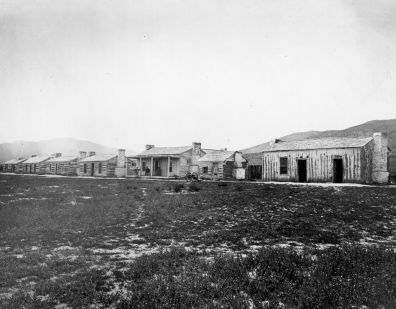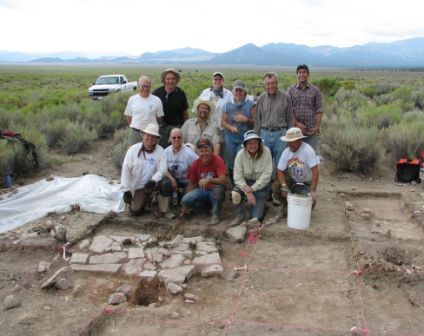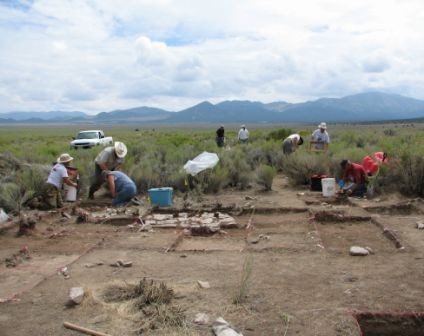Fort Ruby 2007 - Passport in Time
Main menu:
Previous Projects > States M-R
Excavating Fort Ruby II
Humboldt-Toiyabe National Forest, Nevada, 2007
By Lou Ann Speulda-Drews, Historical Archaeologist, USFWS
 (Photo: Fort Ruby, 1868. The palisade building is on the right. Photo courtesy of Timothy O’Sullivan)
(Photo: Fort Ruby, 1868. The palisade building is on the right. Photo courtesy of Timothy O’Sullivan)During the 1860s, the Overland Stage and Mail Service carried both passengers and mail across the western frontier to California. The route crossed Nevada, where attacks and robberies occurred frequently. Increasing numbers of emigrants traveling through the region also caused conflicts with Native Americans. Military protection for travelers and property along the stage route was required and Ruby Valley was chosen as the site of a fort. Fort Ruby was established on September 4, 1862.
In the fall of 1862 a few log buildings were quickly constructed to protect the men from winter weather. Over time, officers’ housing, barracks, a hospital, and Quartermaster’s office were constructed around a parade ground. Soldiers stationed there complained of the rough quarters and monotonous duty.
In 1869 the Overland Stage was rendered obsolete when the transcontinental railroad was completed, as mail and passengers were transported more swiftly by rail than by the stage. Fort Ruby was no longer needed to protect the stage service and by April, 1869, the Fort was officially closed and its buildings sold to local ranchers.
The U.S. Fish and Wildlife Service (FWS) and the U.S.D.A. Forest Service (FS) share responsibility for Fort Ruby. The agencies entered into a partnership to explore the archaeological record, and archaeologists from each agency contributed expertise to develop a research plan and organize an excavation project. We began investigating the site in the summer of 2005 and continued in 2007.
Based on the results of the 2005 work, in 2007 we decided to focus on locating evidence of the officers’ housing during the week-long program. Excavation of 53 1 x 1 meter units resulted in the collection of numerous artifacts which are currently being analyzed.
 (Photo: Fort Ruby 2007 PIT project volunteers with FWS and FS staff standing “inside” the building behind the stones that supported the chimney)
(Photo: Fort Ruby 2007 PIT project volunteers with FWS and FS staff standing “inside” the building behind the stones that supported the chimney)
 (Photo: Fort Ruby 2007 PIT project volunteers with FWS and FS staff standing “inside” the building behind the stones that supported the chimney)
(Photo: Fort Ruby 2007 PIT project volunteers with FWS and FS staff standing “inside” the building behind the stones that supported the chimney)Luckily, evidence of the officers’ row of buildings was found on the very first day. Just beneath the surface were large flat stones that supported a chimney. Extending to the east and west of the stones were the remains of log posts set in the ground. The posts were part of a palisade log building about 20 feet wide that had a stone chimney base centered on the side wall. We were uncertain which direction the building was oriented because the palisade logs were deteriorated in some places, leaving no trace of the wall. We tested at the northern end of where the building should have been and found no evidence. Then we expanded units to the south and found the palisade wall continued to the south. Unfortunately, we didn’t have time to find the other end of the building during this excavation phase. We are fairly confident that the building we located is the northern-most of the officers’ row because it is the only palisade building in the row.
 (Photo: Volunteers learned excavation skills)
(Photo: Volunteers learned excavation skills)Excavations to the south revealed pieces of wood, a trench, and many artifacts, but no obvious building markers. Artifacts included architectural materials such as machine cut (square) nails and window glass as well as household items, but only a few military items such as a button and percussion caps.
The Fort Ruby Project included ten PIT volunteers supervised by FS and USFWS archaeologists. Our volunteers came from as far away as New York and Georgia, with several veterans of the 2005 project. By joining forces and sharing staff time, supplies, and equipment, the agencies succeeded in gathering valuable information with limited funds while sharing the experience with the public.